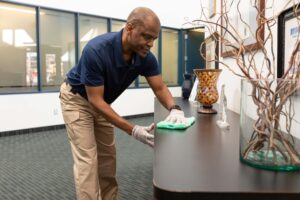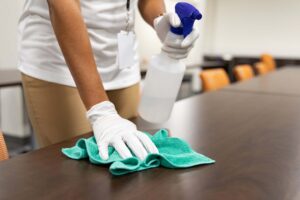When it comes to maintaining a clean and healthy environment, you might think that there isn’t much of a difference between cleaning, disinfecting, and sanitizing.
After all, all three are about making your healthcare facility look as good as possible by removing dirt, dust, grime, and other contaminants from surfaces.
However, while they are all important aspects of infection control, there is a significant difference between them.
In this article, we will cover what cleaning, disinfecting, and sanitizing are and how they differ from one another. We will also provide some tips on how to effectively clean, disinfect, and sanitize your healthcare facility.
Let’s get started!
What is Cleaning?
At a basic level, cleaning is the process of removing visible dirt, dust, and organic substances from surfaces.
This can be done using a variety of methods, including sweeping, mopping, vacuuming, and wiping down surfaces with a clean cloth.
Cleaning is important because it helps to remove potential sources of infection and makes surfaces easier to disinfect. However, cleaning alone will not do much to reduce the level of germs and bacteria on a surface to a safe level.
That’s where sanitizing comes in.
What is Sanitizing?
A step beyond cleaning, sanitizing is the reduction of bacteria on surfaces to a safe level.
This can be done using chemicals, heat, or ultraviolet light.
Sanitizing is different from disinfecting because it does not necessarily kill all germs and bacteria, however, it reduces the number of them to a level that is safe for human contact based on public health standards.
This is important because it helps to prevent the spread of infection, especially in healthcare settings where there is a risk of contact with vulnerable populations.
What is Disinfecting?
Disinfecting is the process of using chemicals to kill germs and bacteria on surfaces. This is an important step in infection control because it helps to reduce the risk of spreading infection.
Disinfecting is different from cleaning because it not only removes dirt and debris but also kills harmful germs and bacteria. This makes it a more effective way of preventing the spread of infection than simply cleaning and sanitizing.
There are a variety of chemicals that can be used for disinfecting, including bleach, alcohol, and quaternary ammonium compounds, but it’s important to have a clear understanding of how to use them correctly in order to be effective.
The Order of Operations
Remember back in school when you learned about the order of operations?
You know, how you can’t just add, subtract, and multiply values in an equation without doing everything in the correct order, or you’ll get the wrong answer?
The same principle applies here.
In order to effectively clean, sanitize, and disinfect your healthcare facility, you need to complete these tasks in the correct order.
You can think of this process like a triangle, similar to Maslow’s Hierarchy of Needs.
At the bottom of the triangle is cleaning, which is the most basic level. This is followed by sanitizing, which is a more advanced level, and then disinfecting, which is the most advanced level.
Each step builds on the next one and cleaning comes first because, in order for sanitizers and disinfectants to be effective, they need to be applied to surfaces that are free of dirt and debris.
If you try to disinfect or sanitize a surface that hasn’t been properly cleaned first, you won’t be as effective in reducing the number of germs and bacteria.
Sanitizing follows because it is a less aggressive way of reducing the number of germs and bacteria on surfaces. This means that it is less likely to cause harm to surfaces and more likely to be effective when used after cleaning.
Disinfecting comes last because it is the most aggressive way of reducing the number of germs and bacteria on surfaces, but requires caution when used since some disinfectants can cause harm to surfaces if not used properly.
Final Thoughts
Now that you understand the difference between cleaning, sanitizing, and disinfecting, the benefits of each, and the order of operations, you’re well on your way to keeping your healthcare facility clean and safe.
It’s important to remember that each of these steps is important in its own way and that they all need to be completed in order to effectively reduce the number of germs and bacteria in a healthcare setting.
If you would like to learn more about how to keep your healthcare facility clean and safe, please contact 1 Stone Solutions today. We are a leading provider of healthcare cleaning services and we would be happy to discuss your specific needs with you.
Contact us today to get started!



